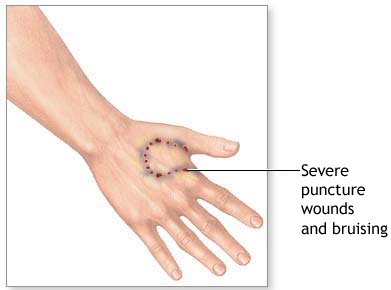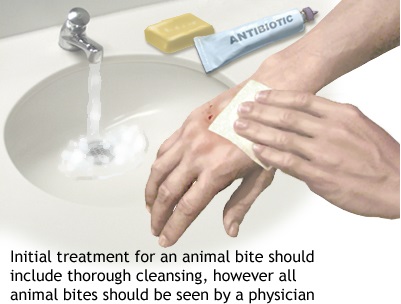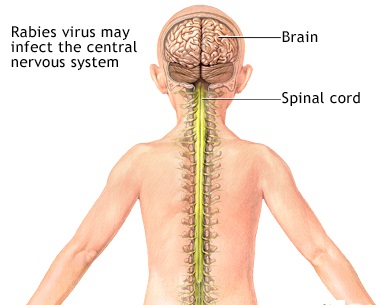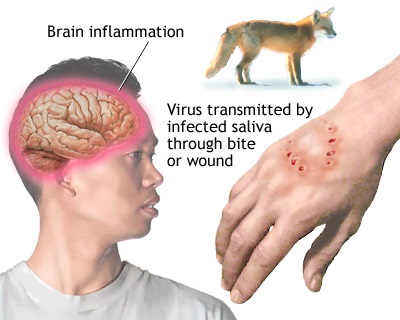
Contents
First aid – Animal bites
Overview:
Many different types of animals ranging from dogs, cats, hamsters, raccoon, ferrets, and squirrels can bite adults and children. Many times, bites are from the family pet.
Definition:
An animal bite can result in a break or tear in the skin, a bruise, or a puncture wound. Animal bites and scratches that break the skin can sometimes cause infection. Some bites need to be closed with stitches while others heal on their own.
Animal Bite Causes:
Animal bites usually are either provoked or unprovoked. A provoked bite would occur if a person teases a dog or tries to take away the dog’s food while the dog is eating. An unprovoked bite may occur if the person are sitting in their backyard and a raccoon runs out of the woods and attacks them for no known reason. A stray dog that approaches a person and begins to bite them would be considered unprovoked. This type of information is very important to health care professional taking care of the bite beside in certain animal species “unprovoked” bites can be a sign or indicator that the animal has rabies and needs to be either captured, quarantined or very closely.
Pets are the most common cause of bites.
- Dog bites are most common.
- Cat bites are less common, but have a higher risk of infection. Cat teeth are longer and sharper, which can cause deeper puncture wounds.
- Stray animals and wild animals, such as skunks, raccoon’s, and bats, also bite thousands of people each year.
Dog bites occur more than any other animal bite and are most frequent in the summer months. The dog is usually known to the person, and most injuries result from the dog being teased or bothered while eating or sleeping. Boys are bitten about twice as often as girls. The arms, head, and neck are the most likely areas to be bitten in children.
Cat bites usually cause deeper puncture wounds than dog bites and have a high risk of bacterial infection because they can be hard to clean adequately.
If you are bitten by a wild animal or an unknown pet, try to keep it in view while you notify animal control authorities for help in capturing it. They will determine if the animal needs to be impounded and checked for rabies. Any animal whose rabies vaccination status is unknown should be captured and quarantined.
Animal Bite Symptoms:
Although most bites need to be checked by a doctor, if the person who was bitten does not seek immediate attention after the bite has occurred, watch closely for signs and symptoms of infection. These symptoms may signal there is infection or debris still in the wound.

- Redness at or around the bite site.
- Swelling.
- Pus (thick) drainage from the wound.
- Increasing pain.
- Localized warmth at the bite site.
- Red streaks leading away from the site of the bite.
- Fever.
Minor wounds:
If the bite barely breaks the skin and there’s no danger of rabies, treat it as a minor wound. Wash the wound thoroughly with soap and water. Apply an antibiotic cream to prevent infection and cover the bite with a clean bandage.
First Aid:![]()
- Calm and reassure the person. Wear latex gloves or wash your hands thoroughly before attending to the wound. Wash hands afterwards, too.
- If the bite is not bleeding severely, wash the wound thoroughly with mild soap and running water for 3 to 5 minutes. Then, cover the bite with antibiotic ointment and a clean dressing.
- If the bite is actively bleeding, apply direct pressure with a clean, dry cloth until the bleeding stops. Raise the area of the bite.
- If the bite is on the hand or fingers, call the doctor right away.
- Over the next 24 to 48 hours, watch the area of the bite for signs of infection (increasing skin redness, swelling, and pain).
- If the bite becomes infected, call the doctor or take the person to an emergency medical center.
Do Not
- Do NOT go near an animal that may have rabies or is acting strangely or aggressively
- Do NOT try to catch it yourself.
If an animal’s behavior is strange, it may be rabid. Notify the proper authorities. The police can always direct you to the proper animal control authorities. Tell them what the animal looks like and where it is so they can capture it.
Procedure, part 1:
To treat a minor bite, first wash your hands thoroughly with soap to avoid infection. Wash hands afterwards as well. If the bite is not bleeding severely, wash the wound thoroughly with mild soap and running water for 3 to 5 minutes. Then cover the bite with antibiotic ointment and a clean dressing.
Procedure, part 2:
If the bite is actively bleeding,apply direct pressure with a clean,dry cloth until the bleeding subsides. Elevate the area of the bite. If the bite is on the hand or fingers, call the doctor right away. Over the next 24 to 48 hours, observe the bite for signs of infection (increasing skin redness, swelling, and pain). If the bite becomes infected, call the doctor or take the person to an emergency facility.
Call immediately for emergency medical assistance if:
Call emergency if the person has been seriously wounded — for example, if the person is bleeding significantly and it will not stop with simple first aid measures.
Call your doctor or go to a hospital emergency room if:
- The person was bitten by an unknown or wild animal.
- The person has not had a tetanus shot within the past 5 years. (If a person has not had a tetanus shot in 5 years, a tetanus shot is recommended within 24 hours of any skin break.)
- There is swelling, redness, pus draining from the wound, or pain.
- The bite is on the face, neck, or hands.
- The bite is deep or large.
- You aren’t sure if the wound needs stitches.
Report the bite to the local animal control authorities, even if you don’t seek professional medical care. This will allow authorities to test the animal and prevent further incidents.
Which dressing to use:
- For large wounds, use a pre-packed sterile wound dressing with a bandage attached, if you have one
- Otherwise, use a sterile pad and secure it with sticky tape. You could also use any clean, non-fluffy material, like a cloth scarf
- For small cuts or grazes you can use a plaster (adhesive dressing).
Deep wounds and infection:

If the animal bite creates a deep puncture of the skin or the skin is badly torn and bleeding, apply pressure with a clean, dry cloth to stop the bleeding and see your doctor.
If you notice signs of infection, such as swelling, redness, increased pain or oozing, see your doctor immediately.
When to Seek Medical Care:
Most animal bites should be evaluated in a doctor’s office, at a walk-in clinic, or in a hospital’s emergency department for these reasons:
- The risk of infection.
- Broken or embedded teeth (cats) or other foreign material in the wound (which will cause an infection).
- Possible underlying nerve and blood vessel damage.
- Risk of tetanus if the person’s immunizations are not up to date.
- The consideration of risk of rabies, depending on the animal and circumstances of the bite
These types of bites pose the highest risk of infection and therefore require prompt evaluation:
- Dog bites because of the crushing mechanism of the bite.
- Cat bites because of the puncture mechanism of the bite.
- Wild animal bites (from raccoon, for example) and dog or cat bites (pets may have themselves been bitten by stray animals) because of the risk of contracting rabies.
Certain bite wounds require immediate attention:![]()
- Bite caused by a wild animal or a stray dog or cat.
- Possibility of teeth, dirt, or other matter in the wound.
- Excessive bleeding.
- Weakness or numbness of the area or another area away from the bite.
- Any other symptoms or concern that the person bitten may have regarding a bite wound.
Animal Bite Prevention
With common sense, a person can lower the risk of being bitten by an animal:
- Avoid contact and interaction with unknown animals. Even animals that appear friendly can bite if provoked.
- Do not feed or try to catch or play with wild animals such as squirrels, raccoon’s, or rats.
- Do not disturb an animal while it is feeding or taking care of its young.
- Use great care when “aggressively” playing with an animal. Even the family dog can bite its owner by accident.
- Do not stick your fingers into animals’ cages (for example, at the pet store, zoo, or dog show).
- Never leave a young child alone with a pet. They often don’t know how to be gentle with the pet, which can cause the pet to get irritated and bite.
- Do not try to separate fighting animals. You may get bit in the process.
- Avoid sick animals and/or animals that you don’t know whether or not they are vaccinated.
- Leave animals alone while they are eating. Animals are often very protective of their food.
Animal Bites Follow-up
When the patient is discharged from the emergency department or leaves the doctor’s office, they should receive instructions on how to care for the bite wound.
Most doctors will recommend a reevaluation of bites in 48 hours to look for infection.
If the wound was sutured (stitches), the doctor will tell the patient when the stitches will need to be removed.
- Typically stitches in the face are removed in 3 to 5 days.
- Stitches over major joints stay in 10 to 14 days.
- Stitches in other areas are removed in 7 to 10 days.
Things to remember:
- If possible, always use disposable gloves to protect yourself and the person you’re trying to help
- The pad needs to cover the skin at least a few centimetres around the wound
- Never touch the part of the dressing that will be in contact with the wound
- If blood seeps through the first bandage, don’t remove it – instead, place another dressing over the top
- If blood seeps through the second dressing, take off both dressings and apply a fresh dressing – make sure you put firm pressure on the wound to help stop the bleeding.
Safety Tips- Treat cat or dog bite
How to treat a cat or dog bite

